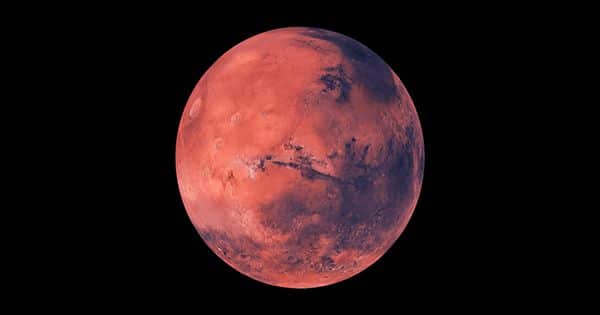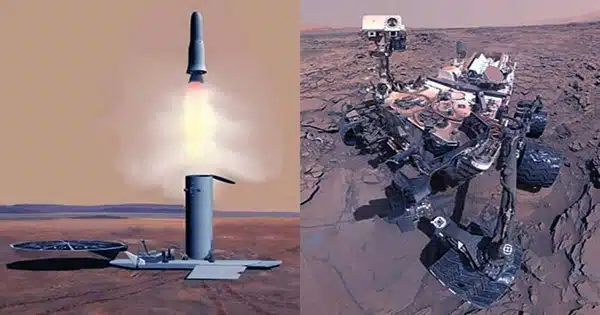PASADENA, California — After an independent evaluation indicated that the existing Mars Sample Return (MSR) design has an “unrealistic” budget and timetable, NASA has begun work to alter its strategy for retrieving samples from Mars.
At an Oct. 20 meeting of the Mars Exploration Program Analysis Group (MEPAG), an advisory body, Sandra Connelly, NASA’s deputy associate administrator for science, stated that the agency has formed a team to address the suggestions given by an independent review board (IRB) in September.
The independent evaluation concluded a “near zero” chance that the next key pieces of MSR, a sample retrieval lander and Earth return orbiter, would be ready for launch in 2027 and 2028 as currently scheduled. It also anticipated MSR expenditures to be in the $8 billion to $11 billion range, significantly higher than prior NASA forecasts.
“We want to make sure that we’re taking into consideration the findings and recommendations so that we can structure this program to be successful and do so within a balanced budget,” Connelly said in a statement.

She is in charge of the MSR IRB Response Team, or MIRT, which is working on a redesigned Mars Sample Return architecture. This team, which met for the first time on Oct. 19, is made up of five subcommittees focused on various technical, scientific, programmatic, and fiscal challenges related to the initiative.
She stated that the MIRT will conclude its work by the end of March, presenting a redesigned architecture for MSR. Some of that effort began even before the team’s formation: One group has been analyzing architectures for the last three to four weeks, according to Jeff Gramling, MSR director at NASA Headquarters.
He proposed picking two or three different architectures for further research this fall, which may include independent cost estimates. He stated that once the agency has chosen a new architecture, the goal is to complete a confirmation review by late 2024, at which point NASA would make formal cost and schedule commitments for the program. NASA had expected to do a confirmation evaluation for MSR this fall.
Uncertainty about how much financing will be available for MSR in fiscal years 2024 and 2025 during this attempt is an additional hurdle for the initiative, which is part of broader disputes about the agency budget. “We don’t know yet what’s going to be appropriated for ’24, so we’re going to have to be skinnying down a bit to fit within ’24 while we pause and step back,” he went on to say.
He didn’t go into detail on the various methods of MSR under consideration. The IRB report proposed numerous options that would delay lander and orbiter launches into the 2030s while using flight-proven technology such as the “skycrane” landing method and a rover based on the Mars Exploration Rover that would recover samples stored by the Perseverance rover.
According to agency officials, there are no plans for a clean-sheet approach to MSR that would start from scratch. “We’re looking to harvest as much of the work that we’ve done to date as possible, but also stepping back and looking at ways we can reduce cost and increasing resilience,” Gramling went on to say.
The evaluation of alternative architectures will be based on numerous figures of merit, including total and per-year costs, technical difficulties, and the updated mission’s scientific value. One example he mentioned was considering lowering the amount of samples returned, which would allow for a smaller Orbiting Sample (OS), the container that would host them. He emphasized that a smaller operating system might minimize the total cost and complexity of the architecture.
Earlier in the conference, Orlando Figueroa, the IRB chair, recognized a lack of maturity in the OS design as a major issue for MSR. The OS would be launched into orbit by a Mars Ascent Vehicle rocket and captured by the Earth Return Orbiter, influencing the design of both. “It is an item that interconnects all of the components of the architecture,” he went on to say.
NASA officials stated that they will collaborate with the European Space Agency, which is in charge of the Earth Return Orbiter, and a robotic arm for sample transfer. “Our ESA partners are tightly coupled into all of this and are also bringing their thoughts and ideas to the table,” Gramling went on to say.
ESA’s director of human and robotic exploration, Daniel Neuenschwander, stated at an Oct. 19 briefing following an ESA Council meeting that the agency was continuing with its contributions to MSR. “We are assessing all options” for MSR, he added, referring to a planned meeting with NASA officials about the program. “It is clear that this assessment has to be done together with NASA, but any way forward will then be subject to member states’ decision.”
Despite its current issues, NASA officials and others at the MEPAG meeting argued NASA should remain committed to Mars Sample Return. “MSR is clearly, logically the next step in our leadership on Mars,” Connelly went on to say. “It does remain a NASA priority.”
The report endorsed MSR as its highest scientific priority while offering recommendations to ensure that it did not become too large a part of NASA’s planetary science portfolio, according to Philip Christensen of Arizona State University, a co-chair of the steering committee that led the development of the planetary science decadal survey published in 2022.
“This is something we should take very seriously,” he added of the suggestion. “This recommendation was reached after a year and a half of discussion and debate.” It was not achieved lightly, and it truly reflects the broad planetary science community’s assessment of the project’s value.”















